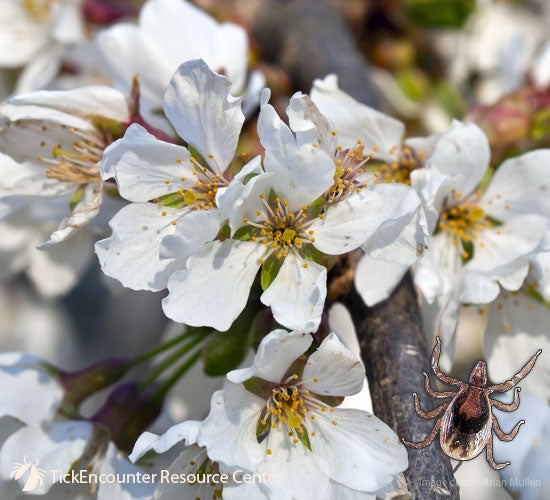April 7, 2012
As the saying goes, “April showers bring May flowers” but this year, many flowers are coming earlier than normal, due to one of the warmest winters on record. The normal “seasonal phenology” [defined as the study of the timing of natural events] has been advanced forward for some organisms by a few weeks or even more. Seeing so many flowers blooming already this early in April reminds us that the principle vector of Lyme disease — nymphal blacklegged ticks (aka. deer ticks) — which usually begin to appear over much of their range in mid-May, are likely to show up even sooner this year.
Several years of tick surveillance research in Rhode Island has shown that nymphal Ixodes scapularis ticks generally start every “tick season” with about the same abundance. However, by season’s end, the surveillance results have shown a high level of inter-annual variability – some years nymphal I. scapularis have been quite abundant, and some years not so much. There have even been years when nymph abundance has been quite low. The number of Lyme disease case reports generally correlates with the seasonal nymphal I. scapularis abundance – more nymphs, more disease – that makes sense, right? It’s interesting to note that none of this variation can be attributable to warmer or colder than normal winter weather. Newer research from The University of Rhode Island’s Center for Vector-Borne Disease being prepared for publication suggests that nymphal deer ticks are quite susceptible to desiccation and that populations of these ticks begin to diminish with increasing exposure to lower relative humidity. They can generally withstand humidity of less than 82% for periods of 8 hours but beyond that, ticks start to die! The occurrence of more tick-adverse (low) humidity episodes, especially if they occur early in the tick season, results in lower tick encounter risk and less disease.
So, this Spring, as you read all of the news headlines about how bad the ticks are expected to be because of the mild winter, the real caveat probably isn’t the warm winter. The warm winter may speed up the phenology and bring the nymphs out a few weeks earlier than normal. GOOD TO KNOW SO YOU CAN START TAKING TICK BITE PROTECTION STEPS EARLY!! But, the real determinant about how “bad” the deer tick season – and correlated risk for Lyme disease – will be, is yet to be determined. We’ll be looking at the Spring and early Summer humidity profiles for our clues to deer tick encounter risk. Stay tuned to TickEncounter – Be TickSmart™. Stay TickSafe!

